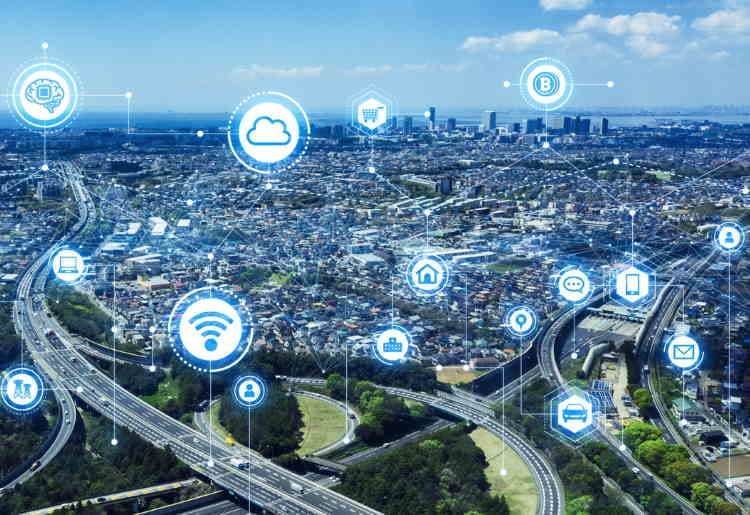Discover how 5G technology plays a pivotal role in the development of smart cities. Learn how 5G’s enhanced connectivity, IoT integration, intelligent transportation systems, and smart infrastructure management empower the creation of efficient, sustainable, and connected urban environments. Explore the transformative impact of 5G on various aspects of smart cities, including public safety, energy management, citizen services, and the seamless integration of advanced technologies like augmented reality and the Internet of Things (IoT).
What is 5G
Key features of 5G technology
- Faster Speeds: 5G networks can provide significantly higher data speeds compared to previous generations. Speeds in the range of several gigabits per second (Gbps) are possible, enabling rapid download and upload of large files, seamless streaming of high-definition content, and faster response times.
- Low Latency: 5G networks offer ultra-low latency, reducing the time it takes for data to travel between devices and the network. This enables real-time, near-instantaneous communication, critical for applications like autonomous vehicles, remote surgery, and industrial automation.
- Greater Capacity: 5G networks can support a significantly higher number of connected devices per unit area. This allows for the widespread deployment of Internet of Things (IoT) devices and sensors, enabling massive machine-to-machine communication and the growth of smart cities and smart homes.
- Improved Reliability: 5G networks are designed to be highly reliable, ensuring consistent and uninterrupted connectivity even in crowded areas or during high-demand situations. This is essential for applications that require constant connectivity, such as public safety, critical infrastructure, and emergency services.
- Network Slicing: 5G introduces the concept of network slicing, which allows network operators to partition a single physical network into multiple virtual networks. Each network slice can be optimized to meet specific requirements of different applications, enabling customized services, security, and quality of service.
- Enhanced Spectrum: 5G utilizes a wider range of frequency bands, including both lower frequency (sub-6 GHz) and higher frequency (mmWave) bands. This allows for greater network capacity, improved coverage, and support for a variety of use cases ranging from rural areas to dense urban environments.
- Edge Computing: 5G networks can be integrated with edge computing, bringing computing resources closer to the network edge. This enables faster processing of data, reduced latency, and supports real-time applications and services.
Pros and Cons of 5G in Smart City Development
Pros of 5G in Smart City Development
- Faster and Reliable Connectivity: 5G offers significantly faster data speeds and low latency, providing seamless connectivity for smart city devices and applications.
- Increased Capacity: 5G networks can support a massive number of connected devices, enabling the widespread deployment of IoT devices and sensors in smart cities.
- Enhanced Efficiency and Productivity: 5G enables real-time data transmission and processing, allowing for more efficient management of urban infrastructure, energy systems, transportation, and other city services.
- Improved Public Safety: With 5G, smart city applications like intelligent surveillance cameras, emergency response systems, and predictive analytics can enhance public safety and emergency management.
- Enhanced Transportation Systems: 5G enables connected and autonomous vehicles, intelligent traffic management, and real-time information services, improving traffic flow, reducing congestion, and enhancing transportation efficiency.
Cons of 5G in Smart City Development:
- Infrastructure Requirements: 5G requires significant infrastructure investments, including the installation of a dense network of small cells and base stations, which can be costly and time-consuming.
- Limited Coverage: Initial 5G deployments may have limited coverage, primarily in densely populated urban areas, which could result in unequal access to 5G services across smart cities.
- Potential Interference: High-frequency 5G signals used in some deployments may be more susceptible to interference from physical obstacles like buildings, trees, and weather conditions.
- Security and Privacy Concerns: The increased connectivity and data sharing in smart cities through 5G networks raise concerns about potential security breaches, data privacy, and the need for robust cybersecurity measures.
- Regulatory Challenges: The deployment of 5G networks in smart cities may face regulatory hurdles, including spectrum allocation, zoning restrictions, and compliance with local regulations.
- Digital Divide: The adoption of 5G in smart cities may exacerbate the digital divide if certain populations or regions lack access to affordable 5G services and devices.
Popular Smart Cities in US
Here are some examples of smart cities in the United States:
- New York City, New York: New York City has implemented various smart city initiatives, including the LinkNYC program that offers free public Wi-Fi, smart street lighting, and sensors for environmental monitoring.
- San Francisco, California: San Francisco is known for its innovative approach to smart city development. It has implemented projects such as smart parking systems, intelligent transportation systems, and renewable energy initiatives.
- Seattle, Washington: This is also the city of Amazon. Seattle has focused on sustainability and technology integration in its smart city efforts. Initiatives include smart buildings, connected streetlights, and data-driven urban planning.
- Chicago, Illinois: Chicago has deployed various smart city projects, including an extensive network of sensors for environmental monitoring, smart traffic management systems, and predictive analytics for public safety.
- Austin, Texas: Austin has embraced smart city technologies in areas such as energy management, transportation, and public safety. It has implemented smart grid initiatives, electric vehicle infrastructure, and smart streetlights.
- Columbus, Ohio: Columbus won the Smart City Challenge from the U.S. Department of Transportation, resulting in numerous smart city projects. These include autonomous shuttles, connected vehicle technology, and an integrated data platform for city services.
- Boston, Massachusetts: Boston has focused on leveraging technology for sustainability and improving quality of life. It has implemented projects such as smart street lighting, smart parking, and connected infrastructure for efficient transportation.
- Atlanta, Georgia: Atlanta has prioritized smart city initiatives, including smart grid technology, intelligent transportation systems, and the Atlanta Information Management Exchange (AMIE) for data sharing and analysis.
- Miami, Florida: Miami has been implementing smart city projects, including smart traffic management systems, connected public transportation, and initiatives for energy efficiency and sustainability.
- Portland, Oregon: Portland has embraced smart city technologies for energy management, transportation, and sustainable urban development. It has initiatives such as electric vehicle infrastructure, smart streetlights, and data-driven transportation planning.
How Does 5G Impact Industries such as Healthcare, Transportation, and Manufacturing?
Healthcare:
- Telemedicine and Remote Healthcare: 5G enables high-quality video conferencing, real-time remote monitoring, and virtual consultations, facilitating telemedicine services. Healthcare professionals can remotely diagnose and treat patients, reducing the need for in-person visits and improving access to healthcare in remote areas.
- Connected Medical Devices: 5G supports the connectivity and data transfer requirements of medical devices and wearables, allowing for real-time monitoring of patients’ vital signs, medication adherence, and health parameters. This enables more proactive and personalized healthcare.
- Enhanced Emergency Response: 5G enables faster and more reliable communication in emergency situations, facilitating quick information exchange between healthcare providers, emergency services, and first responders. This can help improve emergency response times and save lives.
Transportation:
- Connected and Autonomous Vehicles: 5G enables seamless communication between vehicles, infrastructure, and pedestrians, facilitating connected and autonomous driving. It supports real-time exchange of data, enabling features like collision avoidance, traffic optimization, and enhanced navigation systems, improving safety and efficiency on the roads.
- Intelligent Transportation Systems (ITS): 5G enables the deployment of intelligent transportation systems, where vehicles, traffic lights, and other infrastructure elements are interconnected. This allows for efficient traffic management, optimized routing, and better integration of public transportation systems.
- Vehicle-to-Everything (V2X) Communication: 5G supports V2X communication, enabling vehicles to communicate with other vehicles, pedestrians, and roadside infrastructure. This facilitates advanced safety features, such as pedestrian detection, intersection collision warning, and cooperative adaptive cruise control.
Manufacturing
- Industrial Automation: 5G enables reliable and low-latency communication in industrial environments, supporting real-time monitoring and control of manufacturing processes. It facilitates the deployment of connected sensors, robotics, and automation systems, enhancing productivity, efficiency, and safety in factories.
- Predictive Maintenance: With 5G connectivity, machines and equipment can be monitored in real-time, enabling predictive maintenance. Sensors and analytics can provide insights into equipment health, identifying potential failures or maintenance needs in advance, reducing downtime and improving overall equipment effectiveness.
- Remote Operations and Augmented Reality (AR): 5G allows for remote management and control of manufacturing processes, making it possible to monitor and operate machinery from a central location. Additionally, AR technology powered by 5G can enable remote assistance, providing real-time guidance and instructions to workers on the factory floor.
Enhanced Connectivity: 5G networks offer significantly higher data speeds and lower latency compared to previous generations. This allows for seamless connectivity and real-time communication between various devices and systems in a smart city ecosystem.
Internet of Things (IoT) Integration: 5G provides the capacity and scalability required to connect a massive number of IoT devices. This enables efficient monitoring and management of various city infrastructure components, such as sensors, streetlights, waste management systems, transportation systems, and more.
Intelligent Transportation Systems: 5G facilitates the development of advanced transportation systems in smart cities. It enables real-time traffic monitoring, optimized routing, connected vehicles, and vehicle-to-infrastructure (V2I) communication, enhancing safety, reducing congestion, and improving overall transportation efficiency.
Smart Grid Management: 5G enables smart grid systems by providing reliable and high-speed connectivity for monitoring and controlling power distribution. It allows for real-time monitoring of energy usage, efficient management of power grids, and integration of renewable energy sources.
Public Safety and Surveillance: 5G networks support the deployment of advanced video surveillance systems and public safety applications. Real-time high-resolution video streaming, facial recognition, and AI-powered analytics can enhance situational awareness, improve emergency response times, and enhance overall public safety.
Smart Infrastructure Management: 5G enables efficient monitoring and management of critical infrastructure components, such as water and wastewater systems, bridges, buildings, and more. Real-time data collection and analysis help identify maintenance needs, optimize resource utilization, and enhance the overall performance and sustainability of city infrastructure.
Enhanced Citizen Services: 5G enables the delivery of innovative and personalized services to citizens. From smart parking and waste management to remote healthcare services and interactive public displays, 5G connectivity enhances the overall quality of life in a smart city by providing convenient, efficient, and customized services.
Augmented Reality (AR) and Virtual Reality (VR): 5G’s high-speed and low-latency capabilities support the deployment of immersive AR and VR experiences. This opens up opportunities for enhanced urban planning, tourism, entertainment, education, and cultural experiences within a smart city environment.
By providing faster, more reliable, and highly scalable connectivity, 5G technology enables the seamless integration and management of various systems and services in a smart city. It paves the way for increased efficiency, sustainability, safety, and convenience, ultimately improving the overall quality of life for citizens.
Example of Devices Impacted by 5G in Smart Cities
- Smart Traffic Lights: 5G can enable real-time communication between traffic lights and vehicles, optimizing traffic flow and reducing congestion.
- Intelligent Surveillance Cameras: 5G connectivity allows high-resolution video streaming and real-time analytics for enhanced surveillance and public safety in smart cities.
- Connected Streetlights: 5G enables smart street lighting systems that can be remotely controlled and monitored, adjusting brightness based on traffic conditions or energy conservation needs.
- Smart Parking Systems: 5G can facilitate real-time monitoring of parking spaces, allowing drivers to find available parking spots quickly and reducing traffic congestion.
- Environmental Sensors: 5G enables the deployment of IoT sensors for monitoring air quality, noise levels, temperature, and other environmental parameters to support sustainability efforts in smart cities.
- Waste Management Systems: 5G connectivity can improve waste management by enabling real-time monitoring of garbage bins, optimizing waste collection routes, and reducing operational costs.
- Connected Public Transportation: 5G can support real-time information updates, ticketing systems, and improved connectivity in buses, trains, and other modes of public transportation.
- Smart Grids: 5G can facilitate the integration of renewable energy sources, grid management, and demand-response systems for more efficient and sustainable energy distribution.
- Smart Home Devices: 5G connectivity allows for seamless integration and control of various smart home devices, including thermostats, security systems, lighting, and appliances.
- Health Monitoring Devices: 5G supports the integration of wearable devices and remote health monitoring systems, enabling real-time data transmission for personalized healthcare services in smart cities.







